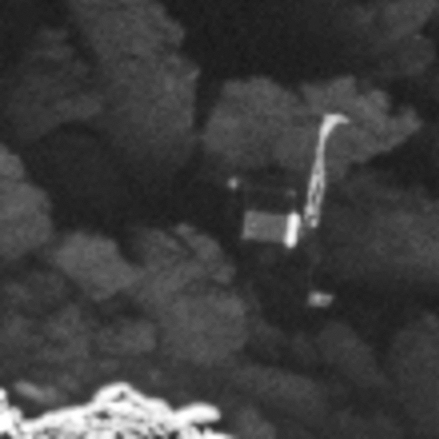Philae found!

Less than a month before Rosetta’s mission ends the spacecraft’s high resolution camera has finally located Philae in its final resting spot on the surface of Comet 67P/C-G.
The images were taken on 2 September by the OSIRIS narrow-angle camera as the orbiter came within 2.7 km of the surface and clearly show the main body of the lander, along with two of its three legs. The images also provide proof of Philae’s orientation, making it clear why establishing communications was so difficult following its landing on 12 November 2014.
The image on the right clearly shows the lander on its side with one leg sticking up, as theorized by the Rosetta engineers based on the small amount of data they had received before Philae went dead. Furthermore, the wide image at the link above shows that the lander landed exactly as predicted by data, up against a wall — in this case a large boulder — which placed it in shadow most of the time.
On Christmas Eve 1968 three Americans became the first humans to visit another world. What they did to celebrate was unexpected and profound, and will be remembered throughout all human history. Genesis: the Story of Apollo 8, Robert Zimmerman's classic history of humanity's first journey to another world, tells that story, and it is now available as both an ebook and an audiobook, both with a foreword by Valerie Anders and a new introduction by Robert Zimmerman.
The print edition can be purchased at Amazon or from any other book seller. If you want an autographed copy the price is $60 for the hardback and $45 for the paperback, plus $8 shipping for each. Go here for purchasing details. The ebook is available everywhere for $5.99 (before discount) at amazon, or direct from my ebook publisher, ebookit. If you buy it from ebookit you don't support the big tech companies and the author gets a bigger cut much sooner.
The audiobook is also available at all these vendors, and is also free with a 30-day trial membership to Audible.
"Not simply about one mission, [Genesis] is also the history of America's quest for the moon... Zimmerman has done a masterful job of tying disparate events together into a solid account of one of America's greatest human triumphs."--San Antonio Express-News

Less than a month before Rosetta’s mission ends the spacecraft’s high resolution camera has finally located Philae in its final resting spot on the surface of Comet 67P/C-G.
The images were taken on 2 September by the OSIRIS narrow-angle camera as the orbiter came within 2.7 km of the surface and clearly show the main body of the lander, along with two of its three legs. The images also provide proof of Philae’s orientation, making it clear why establishing communications was so difficult following its landing on 12 November 2014.
The image on the right clearly shows the lander on its side with one leg sticking up, as theorized by the Rosetta engineers based on the small amount of data they had received before Philae went dead. Furthermore, the wide image at the link above shows that the lander landed exactly as predicted by data, up against a wall — in this case a large boulder — which placed it in shadow most of the time.
On Christmas Eve 1968 three Americans became the first humans to visit another world. What they did to celebrate was unexpected and profound, and will be remembered throughout all human history. Genesis: the Story of Apollo 8, Robert Zimmerman's classic history of humanity's first journey to another world, tells that story, and it is now available as both an ebook and an audiobook, both with a foreword by Valerie Anders and a new introduction by Robert Zimmerman.
The print edition can be purchased at Amazon or from any other book seller. If you want an autographed copy the price is $60 for the hardback and $45 for the paperback, plus $8 shipping for each. Go here for purchasing details. The ebook is available everywhere for $5.99 (before discount) at amazon, or direct from my ebook publisher, ebookit. If you buy it from ebookit you don't support the big tech companies and the author gets a bigger cut much sooner.
The audiobook is also available at all these vendors, and is also free with a 30-day trial membership to Audible.
"Not simply about one mission, [Genesis] is also the history of America's quest for the moon... Zimmerman has done a masterful job of tying disparate events together into a solid account of one of America's greatest human triumphs."--San Antonio Express-News


WOW!
This was completely unexpected, given recently outspoken expectations from the team. And it is so very well imaged! This helps not only the science quality of the radio measurements through the comet between the lander and the orbiter, but it looks good enough to add context information to the images and measurements taken from it.
One option for the landing of Rosetta on the comet was to go all in to find Philae. Instead another landing option was chosen. Now they got both! Great! This was described in a recent Karmán lecture you can google. There’s serious talk interceded by games for the children in the audience. Do skip the games, there are serious explanations too. They gave up expectations of finding Philae. The landing will be done blindly because the solar panels have to be turned away from the Sun, the radio antenna away from Earth, in order to land the spacecraft. And then they hope that batteries will be enough, and the radio dish’s angle to Earth enough, to send back the landing data it will acquire.
Localfluff– do you have that von Karman lecture link handy?
wayne,
Here it is:
http://www.jpl.nasa.gov/events/lectures_archive.php?year=2016&month=8
From August 11.
Again, the speakers also entertain the younger parts of the public. That doesn’t lessen their factual explanations of the missions planned future. Karmán Lectures are by testament intended to reach the broader public. Have a look at their archive for many interesting lectures.
‘fluff-
Thank you.
I would like to think that a lesson learned for future missions would include consideration of a RTG for electrical generation.
Rodney—
— It was a Political Decision to use solar-panels.
If you watch that von Karman lecture on Rosetta (hat tip to Localfluff) an audience member asks about RTG’s, both the presenters stop short of saying it was “political,” but they left no doubt in my mind that using RTG’s was not politically-correct for this mission.
Rodney,
I recommend everyone interested in spaceflight to follow this (almost) weekly telephone conference, FISO, Future of In Space Operations (funny acronym). A slideshow file and an hour long sound file for each of them.
http://spirit.as.utexas.edu/~fiso/archivelist.htm
This one recently dealt with RTG production. It’s like a Rubin Goldberg machine. However, they are stepping up production and will be able to provide one Curiosity or Cassini RTG at least as soon as such mission will be launched in the next few years. The two Europa missions could have theirs, and even a mission to Uranus or so inbetween. My very relieved impression now is that this supply is kind of covered now, in the framework of planned missions.
Europeans don’t get it for Rosetta missions because they (we, I should say) are, and rightly so, not trusted to deal with plutonium.
http://spirit.as.utexas.edu/~fiso/telecon/McNutt_4-16-14/
Aren’t you comforted by the fact that the guy handling this stuff calls himself “MacNut”?
They found the Air France black box several years ago; too bad they can’t fish the Apollo XIII RTG out of the Pacific.